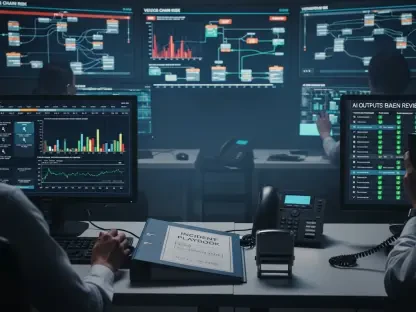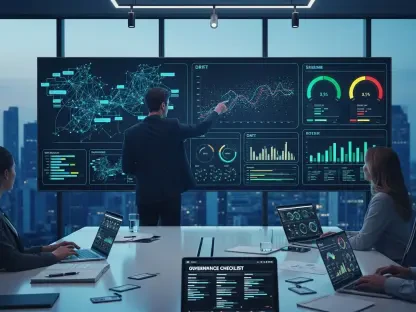Decoding the Cybercrime Surge: Why Ransomware Demands Attention
In an era where digital transformation defines business success, ransomware has emerged as a crippling force, costing global economies billions annually and disrupting operations across industries. Imagine a small business waking up to find its entire database locked, with a demand for payment flashing across the screen—failure to comply risks data leaks or permanent loss. This scenario, far from hypothetical, plays out daily as cyberattacks escalate in both frequency and complexity. This market analysis dives into the ransomware landscape, spotlighting the top five groups responsible for nearly half of all known incidents. It examines current trends, data-driven insights, and projections for the cyber threat environment, while exploring strategic defenses like cyber insurance. The purpose is clear: to equip businesses with the knowledge needed to navigate this high-stakes domain and transform vulnerabilities into resilience.
Dissecting Ransomware Trends: Market Dynamics and Key Players
Historical Growth and Current State of Ransomware Threats
Ransomware has evolved from a niche cyber threat into a dominant force within the cybercrime market, with its growth trajectory reflecting both technological advancements and economic incentives. Initially confined to rudimentary attacks in the late 1980s, the market exploded in the 2010s with the rise of cryptocurrencies like Bitcoin, which enabled anonymous payments. Today, in 2025, the landscape is characterized by organized crime syndicates operating with corporate-like efficiency, often through ransomware-as-a-service (RaaS) models that democratize access to malicious tools. Industry data highlights a steady increase in attack volume, with ransomware maintaining a consistent share of cyber incidents at 17–19% over recent years, signaling a mature yet persistent threat segment.
The impact spans industries, from healthcare to manufacturing, with small and medium-sized enterprises (SMEs) bearing a disproportionate burden. These businesses, often lacking robust defenses, account for 43% of annual cyberattacks, facing average incident costs of $25,000. The market’s current state reveals a dual challenge: while large corporations grab headlines with high-profile breaches, SMEs suffer quietly, often unable to recover from operational or financial setbacks. This disparity underscores a critical market gap—accessible, scalable solutions remain elusive for smaller players despite their vulnerability.
Spotlight on the Top 5 Ransomware Groups: Market Share and Tactics
Driving nearly 48% of known ransomware incidents, five groups—Akira, Play, LockBit, Fog, and RansomHub—dominate the market with distinct strategies and significant reach. Akira leads with a 17.4% share, specializing in double extortion by encrypting data and threatening public leaks, targeting diverse sectors with adaptive techniques that evade traditional defenses. Play, holding 9.2%, leverages a RaaS model, enabling affiliates to amplify attack volume, while LockBit at 7.7% focuses on supply chain exploits and high-value targets, maintaining influence despite enforcement efforts. Fog (7.2%) and RansomHub (6.2%) represent emerging players, using stealthy delayed execution and data exfiltration to maximize pressure on victims, often exploiting regional or sector-specific weaknesses.
These groups collectively shape market dynamics by exploiting common entry points like phishing, which remains the primary attack vector with hundreds of thousands of reported cases annually. Their tactics highlight a broader trend: cybercriminals prioritize speed, scale, and psychological leverage, often hitting multiple victims simultaneously or lingering undetected for weeks. For businesses, this means that outdated systems, unpatched vulnerabilities, and human error are not just risks but active liabilities fueling the ransomware economy.
Emerging Patterns: Technology and Regulatory Shifts
Looking at current patterns, technology plays a dual role in the ransomware market, acting as both a weapon for attackers and a shield for defenders. Cybercriminals increasingly harness artificial intelligence (AI) to automate attacks and craft hyper-targeted phishing campaigns, enhancing precision and success rates. Conversely, defensive strategies are evolving, with AI-driven tools enabling real-time threat detection and continuous monitoring to preempt breaches. This technological arms race is reshaping market expectations, pushing organizations toward proactive rather than reactive measures to stay competitive in risk mitigation.
Regulatory changes are another pivotal trend influencing the ransomware landscape. Stricter data protection laws and mandatory incident reporting requirements are gaining traction globally, aiming to enforce accountability and transparency. These shifts could drive market behavior by incentivizing cybersecurity investments, as non-compliance penalties loom large. Additionally, a growing focus on critical infrastructure and supply chain security—prime targets for groups like LockBit—suggests that future regulations may prioritize sector-specific safeguards, potentially fragmenting the market into tailored risk profiles.
Forecasting the Ransomware Market: Challenges and Opportunities
Projected Growth and Evolving Threats
Projecting forward from 2025 to 2027, the ransomware market is expected to grow in both volume and sophistication, driven by persistent innovation among threat actors. Experts anticipate a sharper focus on critical infrastructure, such as energy grids and transportation networks, as these sectors offer high-impact disruption potential. Supply chain attacks are also likely to surge, exploiting interconnected ecosystems to cascade damage across multiple entities. With AI continuing to lower the barrier for entry, smaller or less-skilled actors could enter the market via RaaS platforms, further inflating incident rates and diversifying attack vectors.
The financial stakes are set to rise as well, with ransom demands potentially escalating as groups target wealthier or more strategic victims. SMEs, already vulnerable, may face intensified pressure due to limited budgets for advanced defenses, perpetuating their status as low-hanging fruit. Market data suggests that without intervention, the average cost per incident could climb beyond current levels, particularly if public data leaks become standard in extortion tactics. This trajectory signals a pressing need for scalable, cost-effective solutions to democratize cybersecurity access across business sizes.
Strategic Defenses: The Role of Cyber Insurance and Innovation
Amid these challenges, opportunities emerge through strategic defenses, with cyber insurance standing out as a transformative market force. Beyond serving as a financial safety net, insurance providers are shifting toward resilience-building, offering services like cybersecurity training, dark web monitoring, and incident response support. This evolution positions insurance as a proactive partner, addressing market gaps by equipping businesses—especially SMEs—with tools to reduce exposure before attacks occur. Adoption rates, currently low among smaller firms, are expected to grow as awareness of cyber risks spreads.
Innovation will also play a critical role in shaping the market’s future. Managed detection and response systems, endpoint protection, and supply chain risk assessments are gaining traction as essential investments for high-risk or larger organizations. Real-time threat intelligence platforms are becoming a cornerstone of defense strategies, enabling businesses to anticipate rather than react to emerging threats. As these tools become more accessible, they could disrupt the ransomware market by shrinking the window of opportunity for attackers, though sustained investment and adoption remain key hurdles to overcome.
Reflecting on the Ransomware Landscape: Strategic Takeaways
Looking back on this analysis, it became evident that ransomware had solidified its position as a dominant cyber threat by 2025, with groups like Akira, Play, LockBit, Fog, and RansomHub commanding nearly half of all incidents through sophisticated, varied tactics. The market had revealed stark disparities, with SMEs disproportionately impacted despite limited resources, while technological and regulatory shifts hinted at both escalating risks and potential safeguards. The dual role of AI—as a tool for attackers and defenders—had underscored an ongoing arms race, shaping a dynamic environment where adaptation was non-negotiable.
For businesses navigating this terrain, actionable steps emerged as critical next moves. Prioritizing foundational defenses such as multi-factor authentication and employee training offered an immediate way to mitigate risks like phishing. Engaging with cyber insurance providers for comprehensive support—not just financial recovery but preventive services—presented a viable strategy to build long-term resilience. Additionally, investing in advanced tools and fostering industry partnerships could position organizations to anticipate future threats, turning the tide against cybercriminals. As the market continues to evolve, staying agile and informed stands as the cornerstone of enduring success in this high-stakes digital battleground.









